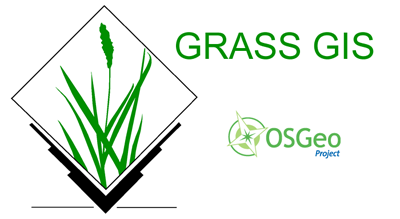GRASS

GRASS is a free, open source software suite used to perform a variety of spatial analyses
GRASS GIS (Geographic Resources Analysis Support System) (link: https://grass.osgeo.org/) is a software package targeting both introductory and advanced users who are interested in creating and analyzing spatial data. Because it can handle both vector and raster datasets, the user can use the software suite for image processing, map production and design, as well as visualization and spatial modeling-based analyses.
Because Grass GIS is an open source software, the community has provided a variety of in-depth tutorials (link: https://grass.osgeo.org/documentation/tutorials/) for the new user. Tutorials are available in a variety of languages, though the English tutorials are the most extensive. Here, the user can learn Geospatial Modeling and Analysis (which is generally equivalent to topics covered in the first 2-3 weeks of a GIS course using ESRI products). Some tutorials are more focused, covering topics including how to use and analyze lidar data, or measure soil erosion patterns. The Grass GIS community is collaborative; on their web page, they have announced a need for volunteers to write tutorials (link: https://grass.osgeo.org/documentation/) – this could be an excellent way for landscape archaeologists to become better integrated in the GIS community!
Having access to a free and complete GIS software suite will be of great use to many archaeological projects, particularly those with limited funds or budgets. Individuals who have been trained in GIS are most likely familiar with an ESRI environment; we suggest running through their GRASS GIS Quickstart guide. This guide includes a sample dataset, and will orient you in this new environment. For the inexperienced GIS user, they should also refer to their list of suggested manuals, tutorials, videos, and books (link: https://grass.osgeo.org/documentation/), which will provide an introduction to both the software, as well as Geographic Information Systems.
Despite the more limited availability of tutorials and user resources in comparison to ESRI products, Grass GIS has an excellent and helpful community of users, is free, customizable, can handle massive data analyses, and is compatible for Macs!
Tutorial Links
For first-time users: https://grass.osgeo.org/documentation/first-time-users/
Here, you will find software and data downloads, as well as the aforementioned introductory sample dataset.
Grass Manuals (versions 6.4, 7.0, and 7.1): https://grass.osgeo.org/documentation/manuals/
Full language list of tutorials: https://grass.osgeo.org/documentation/tutorials/
Youtube tutorials made by Grass GIS: https://www.youtube.com/user/GRASSGISNEWS/videos?view=0
Software/Hardware Requirements
Users can install the binaries or source code version of Grass GIS, depending on whether they want to run the software as-is, or make their own extensions.
Windows: XP or later, both 32 or 64 bit machines are supported.
Mac OS X

